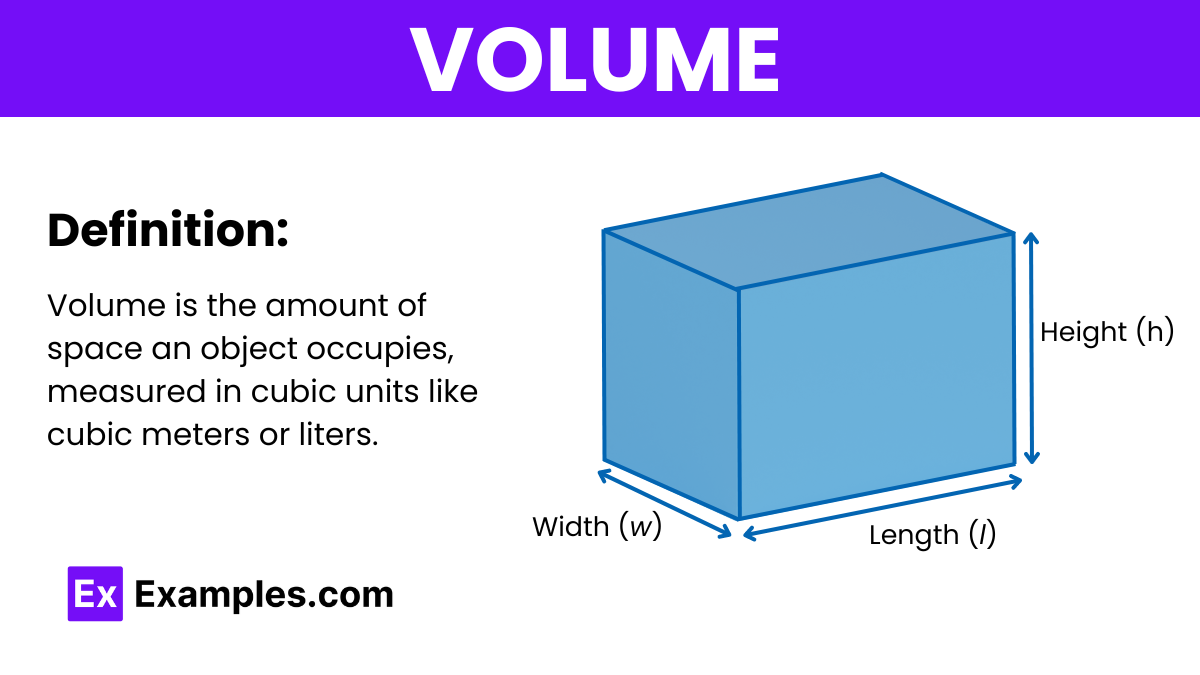What is the formula to calculate the volume of a cube with side length \'a\'?
V = a²
V = 4/3πa³
V = a³
V = πa²


The volume of a solid object is measured in cubic units. This means that if you measure the dimensions (like length, width, and height) of an object in meters, then the volume will be expressed in cubic meters. Cubic meters are the standard unit of volume in the International System of Units (SI), which is used worldwide.
| Shape | Description | Volume Formula | Example |
|---|---|---|---|
| Cube | A solid with six equal square faces. | V = side³ | Side = 3m, V=27 m³ |
| Rectangular Prism | A box shape with six rectangular faces. | V = length × width × height | Length = 10m, Width = 4m, Height = 2m, V=80 m³ |
| Sphere | A perfectly round 3D object. | V = 4/3πradius³ | Radius = 2m, V≈33.51 m³ |
| Cylinder | A shape with two parallel circular bases. | V = πradius² × height | Radius = 1m, Height = 3m, V≈9.42 m³ |
| Cone | A shape with a circular base tapering to a point. | V = 1/3πradius² × height | Radius = 0.5m, Height = 2m, V≈0.52 m³ |
| Pyramid | A solid with a polygon base and triangular sides. | V = 1/3 × base area × height | Base side = 4m, Height = 9m, V=48 m³ |
Let’s say you want to find the volume of a right circular cylinder with a radius of 15 meters and a height of 3 meters. Use π = 3.14 for this calculation.
Solution:
| Unit | Description | Equivalent |
|---|---|---|
| Cubic Meter (m³) | Standard SI unit for volume, used in scientific and construction contexts. | 1 m³ = 1,000 liters |
| Liter (L) | Commonly used for liquids in everyday contexts. | 1 L = 1,000 milliliters (mL) |
| Milliliter (mL) | Often used in cooking and in laboratories. | 1 mL = 0.001 liters |
| Cubic Centimeter (cm³) | Common in medical and automotive applications. | 1 cm³ = 1 mL |
| Gallon (US) | Used in the United States for measuring larger quantities of liquids. | 1 US gallon ≈ 3.785 liters |
| Quart (US) | Smaller than a gallon, used for various liquid measurements in the US. | 1 quart = 0.25 US gallons |
| Pint (US) | Smaller unit used in cooking and some industries in the US. | 1 pint = 0.5 quarts |
| Cubic Inch (in³) | Used in manufacturing and shipping in the United States. | 1 in³ ≈ 16.387 cm³ |
| Cubic Foot (ft³) | Used in shipping, refrigeration, and architectural measurements. | 1 ft³ ≈ 28.317 liters |
| Barrel (oil) | Specifically for measuring volumes of crude oil. | 1 barrel ≈ 159 liters |
This table helps provide a clear and quick reference for converting and understanding different
The SI unit of volume is the cubic meter (m³). Smaller volumes may be measured in cubic centimeters (cm³) or liters.
Volume is typically calculated by the formula: Length × Width × Height for rectangular prisms. Different shapes have specific formulas based on their geometry.
Mass is not directly calculated from volume. However, mass can be determined by multiplying volume by density: Mass = Density × Volume.
Three common methods are: measuring dimensions and applying geometric formulas, displacement of water for irregular objects, and calculation through mass and density.
Text prompt
Add Tone
10 Examples of Public speaking
20 Examples of Gas lighting
What is the formula to calculate the volume of a cube with side length \'a\'?
V = a²
V = 4/3πa³
V = a³
V = πa²
Which unit is commonly used to measure volume in the metric system?
Meters
Kilograms
Liters
Newtons
What is the volume of a rectangular prism with length 5 cm, width 3 cm, and height 4 cm?
60 cm³
12 cm³
20 cm³
30 cm³
How do you calculate the volume of a sphere with radius 'r'?
V = 4/3π
V = 4/3πr³
V = πr³
V = 2/3πr³
What is the volume of a cylinder with radius 2 cm and height 5 cm?
20π cm³
40π cm³
10π cm³
30π cm³
Which geometric shape has a volume calculated by the formula V = πr²h?
Sphere
Cube
Cone
Cylinder
What is the volume of a cone with base radius 3 cm and height 9 cm?
27π cm³
54π cm³
81π cm³
36π cm³
How is the volume of a rectangular tank with a length of 10 m, a width of 4 m, and a height of 2 m determined?
40 m³
80 m³
20 m³
60 m³
What is the volume of a pyramid with a base area of 16 m² and height 9 m?
48 m³
72 m³
144 m³
54 m³
How is the volume of a liquid typically measured in a laboratory?
Kilograms
Liters
Newtons
Meters
Before you leave, take our quick quiz to enhance your learning!

